ODP Leg 170 Costa Rica Subduction Margin
Shipboard Scientific Party
Introduction
To establish the mechanisms of accretion and underplating, tectonic erosion, and deformation and dewatering, essential observations must include (1) the rate (positive and negative) of prism growth as a function of incoming sediment volume and type; (2) the partitioning of frontal offscraping, underplating, internal prism deformation, and subduction erosion; and (3) the effects of fluids. Excellent control is required of material mass-balance and residence time in the prism, in addition to detailed structural geometry of the complex interior regions of forearcs. Such control and imaging is not well established in any convergent margin, despite expending a great amount of effort to understand these margins. The convergent margin off Costa Rica (Fig. 1) satisfies all the requirements necessary to determine accurate mass-balance and flow estimates, except for knowledge of the age and residence time of the prism material.
|
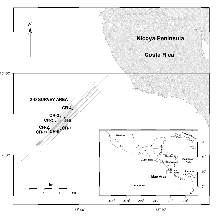
|
Figure 1: Location of 2D and 3D seismic profiles from 1987 cruise of Fred Moore. Inset shows map of Central America, Cocos Plate, and Caribbean Plate. Nicoya Peninsula is located just below the "C" in Costa Rica on the inset drawing. The stippled rectangle shows the location of the 3D seismic grid. The longer lines are 2D profiles. |
|

|
Figure 2: 2D seismic reflection Profile CR-20, showing the location of Sites 1039, 1043, 1040, and 1041 (geometrically projected). Vertical scale is in two-way traveltime. |
Five sites were drilled during Leg 170 (Fig. 2). The major objective of Site 1039 was to serve as a reference site for drilling in the Costa Rica subduction complex. Site 1039 was chosen for its location in the trench axis and away from fault scarps and we used logging-while-drilling (LWD) logs to obtain high-resolution porosity and density measurements. Site 1040 was located 1.6-km landward of the toe-of-slope off the Nicoya Peninsula, Costa Rica. The objective of this site was to pass through the sedimentary wedge near the toe, the dècollement, and the underthrust sedimentary section beneath the dècollement. LWD was a high priority for Site 1040, as it was for Site 1039. Comparison of LWD data from Site 1040 and Site 1039 could provide us with a record of density and porosity of unprecedented detail between a reference site and an underthrust sedimentary section. Site 1041 is located on the midslope of the Costa Rica margin, about 12 km up from the toe-of-slope off the Nicoya Peninsula. The prime objective of this site was to determine the nature and composition of the prism material underlying the slope apron. Site 1042 where the prism reflector occurs at an estimated depth of ~300 mbsf, i.e., 200 m shallower than at Site 1041 had the same objectives as Site 1041. Site 1043 was designed to test whether or not offscraping is temporally and spatially intermittent. Site 1043 was also designed to test whether deformation of the underthrust hemipelagic sediments develops soon after subduction. LWD was a high priority and comparison of LWD data from Sites 1043 and 1039 has provided us with an unprecedented, detailed record of density and porosity between a reference site and an underthrust sedimentary section.
Logging-While-Drilling
Logging while drilling operation (LWD) were conducted for the second time on the JOIDES Resolution since Leg 156. LWD allows in-situ measurements immediately after the drill bit penetrates a formation with instruments that are located at the base of the drill string. These measurements are made before the borehole is adversely affected by the drilling or coring operations. In addition, LWD measurements are made while the drill string is moving, which reduces the chance of sticking and losing the bottom hole assembly (BHA) in a swelling clay or sloughing hole situation. LWD operations were complemented by wireline logging during Leg 170. Tool specifications and depth control are documented by Silver, Kimura, Blum et al. (in press).
Shipboard Results
LWD provided continuous in-situ bulk density, neutron porosity, resistivity, gamma ray, and PEF logs in each sites (Figures, 3, 4B, 4C, 5, and 6).
Site 1039
LWD logs at Hole 1039D show response to several geologic features. Bulk density and resistivity logs are particularly sensitive to changes in porosity and thus compaction state, while gamma ray and PEF logs tend to be more responsive to changes in lithology. The logged records in Hole 1039D are divided into five logging units on the basis of obvious changes in the log responses (Fig. 3).
|
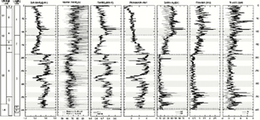
|
Figure 3: Summary of logging-while-drilling (LWD) results showing logging units and lithologic units at Site 1039. SGR: total spectral gamma ray, CGR: computed spectral gamma ray. |
Logging Unit 1 (0-115 mbsf) is characterized by relatively high total spectral gamma ray. The base of logging Unit 1 at 115 mbsf is clearly recognized by changes in bulk density, resistivity, and total spectral gamma ray. However, this depth does not correspond to an identified lithological boundary. Within this unit, the interval 0-3 mbsf is characterized by relatively high resistivity and bulk density, and coincides with lithologic Subunit U1A (ÒturbiditeÓ zone). The interval 3-88 mbsf is characterized by gradual increase of resistivity and bulk density with depth, which coincides with lithologic Subunit U1B (diatomiceous ooze). Strong peaks in gamma ray, resistivity, and bulk density logs occur at the base of the interval (88 mbsf) and correspond to the thick ash layer at the boundary between lithologic Units U1/U2 at 88 mbsf. Logging Unit 2 (115-188 mbsf) is delineated by an abrupt change in resistivity at 115 mbsf and by marked change in every log at 188 mbsf. This unit includes two minor internal changes in log response; a decrease in uranium content occurs at 127 mbsf, and an increase in PEF in found at 138 mbsf which can be correlated to the lithologic Subunit U2A/U2B boundary (base of silty clay). The interval 138-188 mbsf is characterized by intermediate value of total spectral gamma ray, by gradual decreases in resistivity and bulk density, and by an increase in PEF which is consistent with the increasing calcium carbonate (Silver, Kimura, Blum et al., in press). Logging Unit 3 (188-395 mbsf) is characterized by low background values in spectral gamma ray, which corresponds with pelagic sediments. Logging Unit 3 is correlated with lithologic Subunits U3B and U3C. The interval 188-332 mbsf is characterized by low and constant values of total spectral gamma ray. However, resistivity, bulk density, and PEF values show strong fluctuations in the interval 210-227 mbsf, a negative excursion in the interval 267-288 mbsf, and an abrupt increase at 312 mbsf. The low values reflect a decrease in carbonate and an increase in biogenic silica (Silver, Kimura, Blum et al., in press). Two major intervals characterized by high frequency oscillation of the gamma ray peaks are identified at 332-352 and 370-359 mbsf. These can be correlated with ash-rich zones (Silver, Kimura, Blum et al., in press). Logging Unit 4 (395-398 mbsf) shows very high resistivity up to 20 ohm-m, bulk density up to 2.8 g/cm3, and PEF up to 5.2. This interval corresponds to a gabbroic sill recovered in Holes 1039B and 1039C. Logging Unit 5 (398-404 mbsf) is characterized by relatively high resistivity between 0.9 and 1.2 ohm-m, and may correspond to sediments below the gabbroic intrusion. The other logs did not record this deep in the hole.
Site 1040
LWD logs were acquired at two different holes (Holes 1040D and 1040E) at this site. The LWD tools could not penetrate the d?collement zone in two holes. The total logged intervals at Holes 1040D and 1040E are from the seafloor to 325 and 307 mbsf respectively (Figs. 4B and 4C). The differential caliper logs show a very small standoff of approximately 1 inch between the borehole and LWD collars, indicating good hole conditions. Density and porosity measurements roughly correlate with the core specimen measurements (Silver, Kimura, Blum et al., in press). Continuity of values is maintained at about 160 mbsf, where the core-based porosities decrease sharply downwards due to the change from XCB to RCB coring. Although two profiles from Holes 1040D and 1040E generally shows the same trend in density, porosity, and resistivity, they show different log responses in several intervals.
|
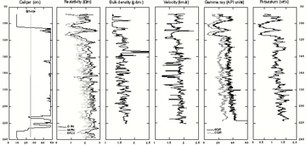
|
Figure 4A: Summary of wireline logging data from Hole 1040C. |
|
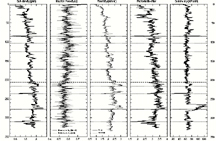
|
Figure 4B: Summary of LWD data Hole 1040D. SGR: total spectral gamma ray, CGR: computed spectral gamma ray. |
|
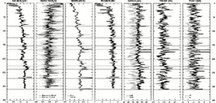
|
Figure 4C: Summary of LWD data Hole 1040E. SGR: total spectral gamma ray, CGR: computed spectral gamma ray. |
|
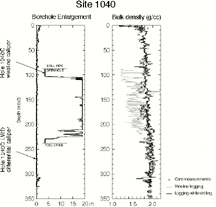
|
Figure 4D: Comparison of bulk density and caliper data from LWD and wireline logging at Site 1040. |
|
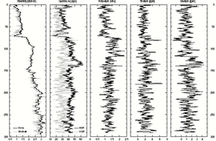
|
Figure 5: Summary of LWD data at Hole 1042C. SGR: total spectral gamma ray, CGR: computed spectral gamma ray. |
|
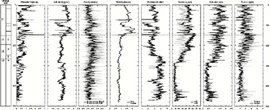
|
Figure 6: Summary of logging-while-drilling (LWD) results showing logging units and lithologic units at Site 1043. SGR: total spectral gamma ray, CGR: computed spectral gamma ray.
|
At Hole 1040C, we deployed wireline logging tools in order to acquire in situ sonic velocity data. Velocity measurements were acquired by the Long Spaced Sonic Tool (LSS) as a part of the wireline logging toolstring. The interval 88-222 mbsf was logged in Hole 1040C (Fig. 4A). Borehole compensated sonic velocity shows a gradual increase from 1700 m/s to 2000 m/s with depth. These values agree well with the few available P-wave velocity measurements from discrete core specimens, although the log data fluctuate much more widely.
Figure 4D shows the comparison of the bulk density and caliper data from LWD and wireline logging at Site 1040. Bulk density data from LWD shows relatively small fluctuation and gradual increase from 1.7 to 2.0 g/cm3, while the bulk density data from wireline logging shows strong fluctuation ranges from 1.2 to 1.8. Differential caliper log at Hole 1040D shows very small stand off of approximately 1 inch, indicating good borehole conditions. Most of the interval in Hole 1040C, the borehole diameter is larger than 20 inch, which is out of density data quality. Therefore, LWD obviously acquired excellent data set in the subduction complex which could not acquired by wireline logging region, although we failed to penatrate the decollement zone.
Site 1042
Main drilling objectives of Site 1042 are to sample the rocks which consist strong seismic reflection in the forearc slope. Only CDR tool was deployed in Hole 1042C because of expected borehole condition. Figure 5 shows resistivity, total gamma ray, potassium, thorium, and uranium logs. The resistivity log shows gradual increasing trend throughout the hole from 1.0 to 3.0 ohm-m. A negative excursion and a significant offset of resistivity values are observed at the interval from 67 to 72 mbsf, which is interpreted as normal fault (Silver, Kimura, Blum et al., in press). There are plenty of peaks of resistivity value below 100 mbsf, which are not occur in gamma ray signature. These peaks of resistivity value are interpreted as gas hydrate layers.
Site 1043
At Hole 1043B, the LWD tool penetrated a d?collement zone and succeeded to provide continuous data across the d?collement zone. The log signatures in the underthrust sequence can be correlated very well to the reference site (Hole 1039D). According to the detailed correlation of the log signatures, the reference sequence was compacted in 83% at the underthrust sequence in Hole 1043B (Silver, Kimura, Blum et al., in press).Figure 7 shows the comparison of the lithology, core physical properties, LWD logs, pore water chemistry, and volatile hydrocarbon profiles. Although bulk density profiles from both core and LWD roughly show the same trend, distinct negative excursions are identified in the interval 70 to 150 mbsf including d?collement zone. The major negative excursions at the intervals 70 to 80 mbsf and 140 to 150 mbsf coincide with the interval of the pore water and gas anomaly, which suggests the interval of the negative excursions of LWD bulk density represent fluid conduit in the subduction complex. Figure 8 shows the summary of the core data and logs cross the dècollement zone. Major shift in gamma ray, bulk density, and resistivity logs occurs at about 140 mbsf and strong excursion features at 147 and 137 mbsf, which are can not detect by the core physical properties. Core recovery in this interval is less than 50%. Therefore, core data can not detect such a geological feature in the d?collement. The in-situ physical property show that the decolemment consist of two major 2-m-thick fractures which may coincide with active fluid conduits.
|

|
Figure 7: Comparison of Core (lithology, age, structure, and bulk density), LWD (bulk density, resistivity, and gamma ray), interstitial water chemistry (salinity and Cl), and volatile hydrocarbon (methane and ethane). |
|
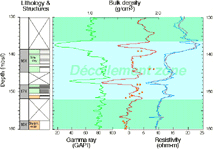
|
Figure 8: Bulk density, resistivity, and spectral gamma ray logs through the dècollement zone at Site 1043. Core data (recovery, lithology, structure, and bulk density) are shown. |
Logging Scientist:
Saneatsu Saito
Reference
Silver, E., Kimura, G., Blum, P., and ODP Leg 170 Shipboard Party, 1998, Proceeding of Ocean Drilling Program, Initial Reports, vol. 170.










